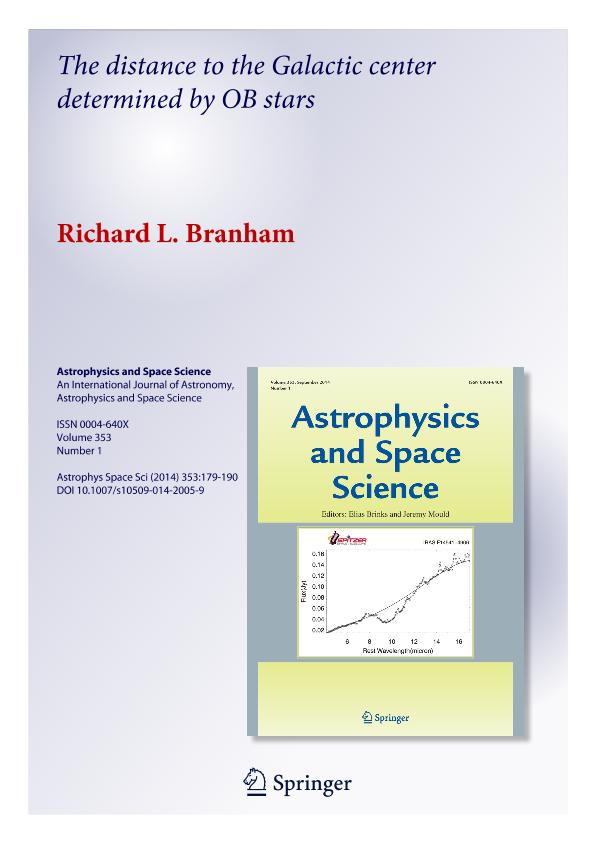Mostrar el registro sencillo del ítem
dc.contributor.author
Branham, Richard Lacy

dc.date.available
2017-12-29T17:56:43Z
dc.date.issued
2014-09
dc.identifier.citation
The distance to the Galactic center determined by OB stars; Springer; Astrophysics And Space Science; 353; 9-2014; 179-190
dc.identifier.issn
0004-640X
dc.identifier.uri
http://hdl.handle.net/11336/31927
dc.description.abstract
The OB stars are concentrated near the Galactic plane and should permit a determination of the distance to the Galactic center. van Leeuwen’s new reduction of the Hipparcos catalog provides, after 824 Gould belt stars have been excluded, 6288 OB stars out to 1 kpc and Westin’s compilation an additional 112 stars between 1 kpc and 3 kpc. The reduction model involves 14 unknowns: the Oort A and B constants, the distance to the Galactic center R0, 2 secondorder partial derivatives, the 3 components of solar motion, a K term, a first order partial derivative for motion perpendicular to the Galactic plane, a second-order partial for acceleration perpendicular to the plane, two terms for a possible expansion of the OB stars, and a C constant. The model is nonlinear, and the unknowns are calculated by use the simplex algorithm for nonlinear adjustment applied to 14313 equations of condition, 12694 in proper motion and 1619 in radial velocity. Various solutions were tried: an L1 solution, a least squares solution with modest (2.7 %) trim of the data, and two robust least squares solutions (biweight and Welsch weighting) with more extreme trimming. The Welsch solution seems to give the best results and calculates a distance to the Galactic center 6.72 ± 0.39 kpc. Statistical tests show that the data are homogeneous, that the reduction model seems adequate and conforms with the assumptions used in its derivation, and that the post-fit residuals are random. Inclusion of more terms, such as streaming motion induced by Galactic density waves, degrades the solution.
dc.format
application/pdf
dc.language.iso
eng
dc.publisher
Springer

dc.rights
info:eu-repo/semantics/openAccess
dc.rights.uri
https://creativecommons.org/licenses/by-nc-sa/2.5/ar/
dc.subject
Galaxy: Dynamica And Kinematics
dc.subject
Methods: Data Analysis
dc.subject
Methods: Numerical
dc.subject.classification
Astronomía

dc.subject.classification
Ciencias Físicas

dc.subject.classification
CIENCIAS NATURALES Y EXACTAS

dc.title
The distance to the Galactic center determined by OB stars
dc.type
info:eu-repo/semantics/article
dc.type
info:ar-repo/semantics/artículo
dc.type
info:eu-repo/semantics/publishedVersion
dc.date.updated
2017-12-29T14:09:14Z
dc.journal.number
353
dc.journal.pagination
179-190
dc.journal.pais
Alemania

dc.journal.ciudad
Berlin
dc.description.fil
Fil: Branham, Richard Lacy. Consejo Nacional de Investigaciones Científicas y Técnicas. Centro Científico Tecnológico Conicet - Mendoza. Instituto Argentino de Nivología, Glaciología y Ciencias Ambientales. Provincia de Mendoza. Instituto Argentino de Nivología, Glaciología y Ciencias Ambientales. Universidad Nacional de Cuyo. Instituto Argentino de Nivología, Glaciología y Ciencias Ambientales; Argentina
dc.journal.title
Astrophysics And Space Science

dc.relation.alternativeid
info:eu-repo/semantics/altIdentifier/doi/http://dx.doi.org/10.1007/s10509-014-2005-9
dc.relation.alternativeid
info:eu-repo/semantics/altIdentifier/url/https://link.springer.com/article/10.1007%2Fs10509-014-2005-9
Archivos asociados
